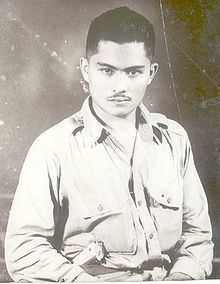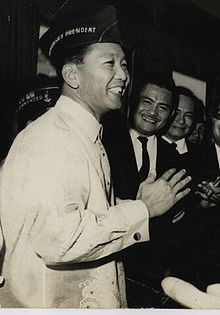- Salvador A. Rodolfo, Sr.
-
Col. Salvador Rodolfo, Sr. (born 7 February 1919) is a Filipino War Hero who liberated the Island Province of Catanduanes in the Philippines from the clutches of the Japanese Imperial Army during World War II. He was known in Catanduanes as “Phantom” or the “Man who Never Dies” based on the comic book hero created by Lee Falk in 1936.
He organized the Catanduanes Liberation Forces (CLF), the guerilla unit that paved the way for the liberation of Catanduanes in 1945. The CLF fought the Japanese without any external help. They were fearless and fought so hard that the Japanese forces were virtually destroyed before even the American forces, the supposed liberators, arrived in Catanduanes in 1945.[1]
Contents
Personal life
Rodolfo was born in 1919 in Bato, Catanduanes, Philippines. He is a descendant of Don Juan Rodolfo of Almeria, Spain who went to the Philippines in the 18th Century and married the daughter of Datu Bantog who was then one of the Tribal Chieftains in Catanduanes in order to put to a halt the hostilities between the natives and the Spaniards. The Rodolfos have played an important role in Catanduanes politics the Spanish Colonial Period. His father, Roman Rodolfo was an undefeated Mayor of Bato and his mother, Maria Tan Arambulo, was a Chinese businesswoman.
World War II
When the Second World War broke out, Rodolfo was called to arms in defense of the Philippines against the invading Japanese Imperial Forces. He fought in the three-month Battle of Bataan in 1942, and is a survivor of the Bataan Death March, a Japanese war crime in which thousands of prisoners of war were forcibly transported after being defeated. While in Camp O’Donnel in Capas, Tarlac, he met the then Lt. Ferdinand E. Marcos, who would later on become President of the Philippines. He was released later. After being released from the concentration camp in Capas, Tarlac, Rodolfo organized the Catanduanes Liberation Forces.
Catanduanes Liberation Forces
The Catanduanes Liberation Forces[2] headed and organized by Rodolfo was the back bone of the resistance movement in Catanduanes. It performed numerous ambuscades against the Japanese Imperial Army and conducted intelligence gathering, which was necessary in paving the way for the eventual liberation of the province by the Americans. During his exploits as a guerilla leader, Rodolfo was rumored several times to have been killed in battle but time and again he keeps on coming back to destroy every vestige of enemy control in the province of Catanduanes, hence he was called “Phantom” or the Man who never dies.
Liberation
On February 8, 1945, when Rodolfo was about to declare the independence of the province after he and his men killed every Japanese Imperial Army and burned every Japanese garrison in Catanduanes, one of his men approached him and said that there were Japanese reinforcements on board 2 vessels approaching the island. He then talked to his men, most of whom were wounded and exhausted, he said:
Japanese reinforcements are coming. I have two options for you, we can go to the hills and save ourselves and wait there until the Americans arrive, but I assure you that all civilians left behind will be massacred by the incoming Japanese, or we can repeat what happened in the Battle of Thermopylae and stand our ground. Most of us will die, but we will live forever in the pages of history as the men who fought for the liberation of Catanduanes"
With that, everybody decided to stand their ground and fight the incoming Japanese. They went to their posts to wait for the enemy’s arrival but then, as if by providence, American planes arrived and bombed the Japanese vessels. Rodolfo declared independence of the entire province on February 8, 1945.[3]
References
- History of Catanduanes, Bernardo C. Vargas (1991)
- Rebellion in Catanduanes, Perry M. Calara, Kaiba News and Features, August 15, 2002 v.18
Categories:- 1919 births
- Possibly living people
- Filipino people of Chinese descent
- Filipino people of Spanish descent
- World War II Pacific Theatre
Wikimedia Foundation. 2010.


